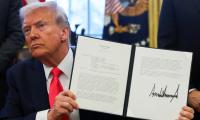The associated hype and hyperbole over the government's decision to ban Rs 500 and Rs 1000 notes simply seems to exploit the financial and economic illiteracy that is prevalent even among the educated middle class who haven’t comprehended the issue, let alone the rural illiterate, says Sridhar Aiyangar.
Illustration: Uttam Ghosh/Rediff.com.

Let me at the outset say that I welcome the demonetisation move but do not support:
- the shock and awe approach that has caused hardships to a vast majority of citizens for the limited benefit this may deliver (more about this later); and
- the hype and hyperbole that this action will deliver a death blow to corruption and black money, which it certainly will not, as the problem of corruption and unaccounted wealth is much bigger and is not limited to hoarding of cash, which if anything is less than 5% of the total black money.
Hence, the claims by the government that this will end the menace of black money and corruption are simply outlandish. Also, the simultaneous introduction of Rs 2,000 note undermines their claim and it simply does not fit the storyline of an attack on black money and corruption.
Now, let's look at the extent of the possible real benefits of this move.
As noted above, to say that this will sound a death knell to corruption and black money is a massive overstretch and a great exaggeration, and I will come to that in a bit. But those who are going on an overdrive about this being an unprecedented move of epic proportions and the next best thing since sliced bread, need to read up a bit of history.
This has happened in the past in India in 1978 and again to a limited extent in 2005 when older notes were recalled but in a more orderly and sensible manner. This has also been tried in many other countries and what these experiences tell us is that demonetisation on its own has a very limited effect for a short while unless backed with several other measures of surveillance.
This is simply because of the fact that significant amount of black money is held via overseas bank accounts or in offshore real assets through a web of shell companies, a fact acknowledged earlier by the ruling party prior to general elections.
However, equally it’s undeniable that some portion of it is also held domestically but a bulk of this is in the form of real estate, financial assets through trusts, gold and some amount of it in cash.
And it's the last part of this that demonetisation will address and deliver some benefit. This was also the political position of the ruling party back in 2005 when they protested against a move by the previous government to recall higher denomination notes. So, what are the real benefits of this move?
Let’s look at some of the specifics around expected benefits of this demonetisation and the ways in which this may have an impact:
- For starters, it will invalidate the fake notes being pumped in by some of our neighbours through Nepal and other porous borders;
- It will bring more cash into the banking system, as even legitimately held cash with people will find its way into the banks, at least for some time (until the cash withdrawal limits are increased);
- It will bring some amount of unaccounted cash which may either flow back into the banks where people simply decide to account for it and pay tax or otherwise use their extended family and friends network to split the amounts into smaller amounts to recycle into the banking network; and
- Finally, some cash may simply be unclaimed (though highly unlikely with the Indian jugaad system).
The benefits case
1. Fake Currency
The issue of fake currency was becoming a serious menace and this move clearly stamps it out. It will take a while for them to master the art of new notes that have, purportedly, advanced security features. However, the immediate adverse impact of this will be felt in the form of slower GDP growth and lower consumer spending. The positive effect may be in the form of Inflation trending lower because of this.
2. Cash flowing into the banking system
Irrespective of having a bank account, people legitimately hold cash for their routine and emergency requirements. This move will result in this cash flowing back into the bank, only to be withdrawn after a while. So this will only result in a temporary improvement in the liquidity position of banks as it will leave once the new notes are available and withdrawal limits are lifted. So the real benefit from this is questionable.
However, the cash that was not previously within the banking system will flow into it for the first time. This will lead to an increase in bank deposits and perhaps a reasonable amount of this may stay for a longer period. To the extent of the stability of these deposits, this may help the credit creation process. However, for the credit creation to occur, the PSU banks that are weighed down by non-performing loans have to be recapitalised. So, no tangible benefit to the economy until and unless the banks are recapitalised.
3. Unaccounted cash flowing back
This is potentially what the government is really targeting. If some element of unaccounted money finds its way back into the system, this will help in improving the tax intake and the government stands to benefit. Given the ingenuity of these individuals in protecting their cash, it remains to be seen whether this yields a big tax collection or results in just an increase in number of bank accounts and balances as hoarders find ways to split the amounts.
It has to be noted that the recently concluded income declaration scheme in September 2016, resulted in an income disclosure of Rs 65,000 crores ($10bn) and netted a tax take of Rs 29,000 crores ($4.5 bn), much less than the expected hundreds of billions of $.
4. Unclaimed balances
And finally any unclaimed notes in circulation, a highly unlikely scenario as people will find ways to recycle (remember, India is a land of jugaad), will result in a clear benefit to the RBI and the government, as the RBI can extinguish its liabilities to this extent. This gain can be used by the RBI to pay dividend to the government which reduce the fiscal deficit. But this process cannot begin until the next fiscal year which is when the aggregate of unclaimed balances will be known as the RBI's window for accepting notes extends to March 31, 2017.
Now let's compare the magnitude of black money and the minimal extent to which this action is going to address the problem.
The total money in circulation according RBI statistics is Rs 16.4 lakh crores ($250bn if you can't wrap your head around that). Of this, about 86% or Rs 14.2 lakh crores ($ 215bn) is represented by Rs 500 and Rs 1,000 notes as per table below.
Rs 500 and Rs 1000 notes in circulation
Volume (in crore pieces)
| Denomination(Rs) | March-14 | March-15 | March-16 |
|---|---|---|---|
| 500 | 1141 | 1313 | 1571 |
| (% share) | 14.7 | 15.7 | 17.4 |
| 1000 | 508 | 561 | 633 |
| (% share) | 6.6 | 6.7 | 7.0 |
| 500 and 1000 together | 1649 | 1874 | 2203 |
| (% share) | 21.3 | 22.4 | 24.4 |
| Total of all notes | 7733 | 8358 | 9027 |
Value (Rs lakh crore)
| Denomination(Rs) | March-14 | March-15 | March-16 |
|---|---|---|---|
| 500 | 5.7 | 6.6 | 7.9 |
| (% share) | 44.4 | 45.9 | 47.8 |
| 1000 | 5.1 | 5.6 | 6.3 |
| (% share) | 39.6 | 39.3 | 38.5 |
| 500 and 1000 together | 10.8 | 12.2 | 14.2 |
| (% share) | 84.1 | 85.2 | 86.4 |
| Total of all notes | 12.8 | 14.3 | 16.4 |
Source: RBI
According to the RBI's statistics, Scheduled Banks in India hold about Rs 6 lakh crores ($91bn) in Rs 500/Rs 1000 notes after applying the 86% on their total cash holdings to estimate the amount held in Rs 500 and Rs1,000 notes, in their branches and ATMs.
Then you have organisations like the railways, post offices, PSUs, corporates, petrol pumps, hospitals, government offices, businesses and traders holding cash as part of their legitimate daily activities. Assuming that the legitimate portion of the cash holdings to be 2/3rd levels of banks (based on an estimate that recognises that the number of corporates, traders, organisations significantly outnumber the banks by several hundred folds), it comes to Rs 4 lakh crore ($60bn), then the remaining cash amount reduces to less than half of the total. So that leaves the balance cash at Rs 4.2 lakh crores (or $64bn). The table below shows the estimates:
| Details | Rs (Crores) | ~ USD billions | % to total cash in circulation |
|---|---|---|---|
| Aggregate money in circulation (RBI statistics) | 1,640,000 | 250 | 100% |
| Aggregate money in Rs 500 and Rs 1,000 notes (86% of total per RBI Statistics) | 1,420,000 | 215 | 86% |
| Money held with Scheduled Commercial Banks (branches and ATMs) (estimated at 86% of total cash in Rs 500/1000 notes) | 6,00,000 | 91 | 36% |
| Estimated cash with post Office, corporates, railways, traders, petrol pumps, govt. etc. | 4,00,000 | 45 | 18% |
| Estimated balance left with individuals(surprisingly a number we associate with fraud and cheating!) | 4,20,000 | 64 | 26% |
Out of the estimated amount of cash held by individuals, we can make a reasonable split of cash held by urban and rural folks:
- Urban India: Legitimately held cash for routine and emergency expenses (assuming an average of Rs 2,500 per person for the 400 million urban population) = Rs 1 lakh crore ($15bn)
- Rural and Semi Urban: Mainly cash users or not in the banking system, say, an average of Rs 500 for the 800 million = Rs 40,000 crores ($6bn)
So, if we adjust the legitimate amounts held by individuals of Rs 1.4 lakh crores ($21bn) from the aggregate Rs 4.2 lakh crores ($64bn) of balances with individuals, the net estimated amount of unaccounted cash would be Rs 2.8 lakh crores or $ 43bn.
But this is just about 2% of our GDP!
Now cutting out all the noise, compare this to the total unaccounted money which was estimated to be $1 trillion and you can very easily see that it represents less than 5% of the black money problem.
Even if we made an overly optimistic assumption that the entire amount of $43bn can be recognised as a gain either through tax take or unclaimed balances, this would still represent only 4.3% of the total black money problem. While this is still a welcome development and needs to be applauded, it needs to be kept in the context of the magnitude of the overall problem.
So I would say to all those screaming that this will end black money that after all the noise subsides and the chest thumping is over, please realise that the black money problem is far from over! We have just scratched the surface.
But the reintroduction of higher denomination notes will only make the problem worse unless further measure to curb cash transactions are introduced.
So was the midnight strike really necessary and worth it?
Now let’s look at the dramatic way in which this decision was announced. The move took many by surprise and the reactions in social media has since moved from an initial euphoria to a state of chaos and panic that has left crores of citizens on the streets queuing in front of banks and ATMs looking for the right kind of cash (as lower denominations are only 14% of stock in circulation trying to replace 44% of cash that needs to be replaced!).
To top it, the new currency notes do not fit the ATM machines and it will take more than a couple of weeks for ATMs to deliver the higher denomination notes of Rs 500 and Rs 2,000! And the government says it has been planning this operation for well over six months!
In my opinion, the benefits of this surprise element are being significantly overplayed by the government. If the government is conducting inspections of gold traders and other places of suspected of conversion of cash, they could still adopt the same process of surveillance and could have given people a reasonable notice to organise their lives. This would have resulted in an orderly withdrawal of old notes and still snuff out the fake currencies without the attendant chaos and hardships to a large section of the population for a limited benefit!
The immediate withdrawal is unjustified as it results in hardships to 99% of the population to attack 1% of hoarders. More so, when taken in the overall context of the contribution of unaccounted cash to the black money problem as bulk of it is held overseas in offshore assets or in real estate or in gold.
While people can be asked to make sacrifices for the nation’s cause, this seemingly ill-planned execution together with its limited benefits does not quite fit that bill. The simultaneous introduction of the higher denomination Rs 2,000 note blows a hole into that argument as it clearly defeats the purpose of stamping out black money! All this exercise does, at best, is to reset the base for a small part of the overall issue which could have been managed better.
Hence, the government’s claim that this action will stamp out black money is tenuous and a fantasy as the Rs 2,000 note will only accentuate the problem of black money creation. While the move is intended to catch the cash hoarders unawares, there are other effective administrative tools in the form of better surveillance, improving the analytics and intelligence network, and taking action against those who facilitate the fake currency trade from our side of the border.
Conclusion
The monetisation move is to be welcomed as there will be some benefit from this exercise but the justification for a sudden withdrawal is questionable as the surveillance on exchange of notes could have ensured that even orderly withdrawal would succeed.
If the government is seriously minded to tackle the black money menace, it has to focus on the 96% of the problem and work with other G20 members on information sharing and take prompt action. So far nothing much has been heard on this front after the initial claim of 650 odd names. Even the Supreme Court has now stopped asking for updates! So the judiciary is also sleeping at the wheel.
I also question the associated hype and hyperbole, which simply seems to exploit the financial and economic illiteracy that is prevalent even among the educated middle class who haven’t comprehended the issue, let alone the rural illiterate.
While there is some gain to the government in the form of a potential tax take or unclaimed balances which will help to reduce the fiscal deficit, but to proclaim that this is the end of corruption and black money is far-fetched.
This move is neither going to deliver a death knell to corruption nor eradicate black money! And the rhetoric doesn’t gel with the simultaneous introduction of the higher denomination note!! The shock and awe approach doesn’t quite justify the hardship inflicted on millions of ordinary folks.
Reproduced with kind courtesy, from Sridhar Aiyangar's blog post.
Sridhar Aiyangar is a senior banker and an executive leader with expertise in key facets of banking, viz, treasury, finance and risk management within large MNC banks.














 © 2025
© 2025